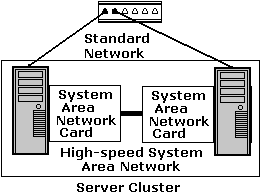System Area Network Interface Cards
By Stephen Bucaro
In organizations with large critical mission networks, servers are arranged in
clusters. In a cluster servers are configured to share resources such as
storage and processing as if they were a single more powerful server. If a
server in a cluster fails, the other servers in the cluster take over for it
and continue processing (called "fail-over").

Servers in a cluster can be configured to communicate with each other the
standard network, but in order to achieve the high level of performance
required, they usually communicate with each other directly over a separate
higher speed and higher reliability System Area Network.
Whereas the standard network may use twisted-pair cabling, the System Area
Network may use separate fiber-optic cabling. System Area Network
interface cards are special high speed circuits that provide communications
between the servers over the System Area Network.
If there are only two servers in a cluster, their System Area Network Interface
Cards can be connected directly to each other by a cable. If there are more
than two servers, a special hub is used to provide the connection.
More Networking Topologies Articles:
• What Are Pseudo-Wires?
• Cable: Cat5, Cat5e, Cat6, Cat6A ; What's the Difference?
• The Difference Between a Broadcast Domain and a Collision Domain
• Frame Relay WAN Protocol
• Token Ring Network
• Wireless or Wired Network?
• Spanning Tree Protocol (STP) Operation
• The Complete Guide to Fiber Optic Connectors
• Trunking, Bonding, Aggregation; What Does it Mean?
• A Guide to Broadband Internet Connections
| 
